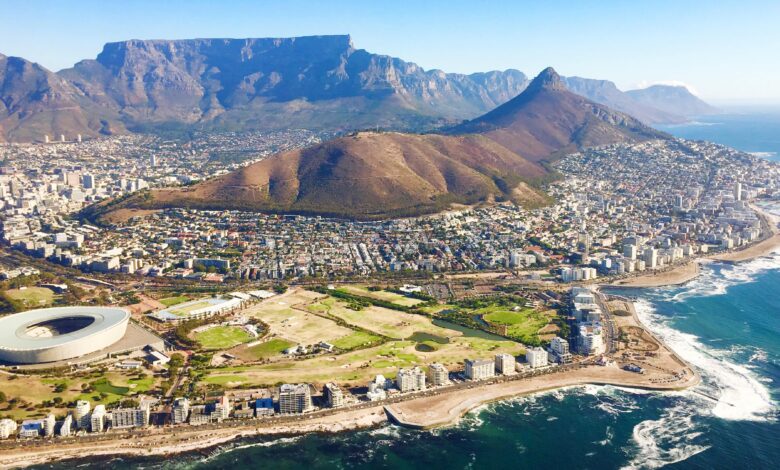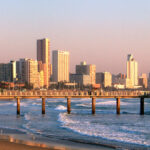Cape Town

Cape Town, located in South Africa, is a city with a rich history and unique geography. Nestled between Table Mountain and Table Bay, the first settlement of Cape Town was bounded by Lion’s Head and Lion’s Rump to the northwest, Devil’s Peak to the south, and marshlands and the sandy Cape Flats to the east. These natural features played a significant role in shaping the direction of Cape Town’s growth and continue to influence its layout and infrastructure today.
The Early Settlement and Development
The earliest settlement of Cape Town was situated in the area between Table Mountain and Table Bay. The fertile land for cultivation was found on the lower eastern slopes of Devil’s Peak, Table Mountain, and in areas further southeast such as Rondebosch, Newlands, and Wynberg. The settlement was strategically located near the fortress, from where a track led south to False Bay, providing shelter for East Indiaman trade ships during winter gales.
Over time, road and rail construction followed the pattern set by the natural landscape. In 1864, a railway line reached Wynberg, and in 1883, it extended to Muizenberg. Another railway line ran eastward from Cape Town, crossing the Cape Flats to reach the interior. These transportation developments facilitated the movement of people and goods, contributing to the city’s growth and economic prosperity.
Climate and Natural Influences
Cape Town’s climate is Mediterranean, characterized by mild, wet winters and warm, dry summers. The presence of Table Mountain and the cold Benguela Current of the South Atlantic Ocean locally modifies the climate. The average high temperature in January and February is around 70°F (21°C), while the average low in July is approximately 55°F (13°C). However, temperatures can be cooler on the mountain slopes and coastal areas. Freezing temperatures are rare in Cape Town.
Rainfall occurs on an average of 69 days per year, with half of the annual rainfall of 26 inches (660 millimeters) happening between June and August, during the southern winter. The amount of rainfall varies depending on the proximity to the mountain, with areas closer to the slopes receiving more precipitation. The prevailing winds, generally strong, come from the northwest in winter and from the southeast to southwest in summer. Southerly winds create a cloud cover over Table Mountain, commonly known as the “tablecloth.” These winds, known as the “Cape doctor,” help maintain low levels of air pollution in the city.
The Layout of Cape Town
The early settlement of Cape Town had narrow streets that ran parallel to the shore. The main thoroughfare was originally called the Heerengracht, which led from the shore inland to the Dutch East India Company’s produce garden. It was later renamed Adderley Street in 1850. As the town grew, other main roads developed parallel to Adderley Street. The Castle of Good Hope, built by the Dutch East India Company between 1666 and 1679, stands on what was once the shore of Table Bay, in Strand Street.
The Botanic Gardens, bisected by Government Avenue and overlooked by government buildings, are located near the Castle. The parliament building, originally constructed for the colonial government and later becoming the seat of the Parliament of the Union of South Africa in 1910 and the Republic of South Africa in 1961, is also situated nearby. Additions to the building were completed in 1987.
Development along the shore was rejuvenated with the opening of the Alfred Dock in 1870. The breakwater was extended, piers were constructed between 1890 and 1895, and the sheltered area became known as Victoria Basin. Subsequent dredging for the Duncan Dock in 1938-1945 and the Ben Schoeman Dock in 1977 led to the reclamation of 480 acres (194 hectares) of land along the shore, referred to as the Foreshore. Adderley Street was extended to the new harbor, and the extension was named the Heerengracht.
Transportation and Suburban Growth
The development of a modern freeway system has greatly facilitated movement between Cape Town and its suburbs. This has resulted in a significant increase in population and commercial activity in the southern suburbs, particularly in areas such as Claremont and Wynberg. The slopes east of Table Mountain and Signal Hill, overlooking Bantry Bay and the beaches of Clifton, have become highly sought-after residential areas.
Architectural Influences and Styles
Cape Town’s early architecture took inspiration from Dutch prototypes, which were adapted to suit the local region. Distinctive features included flat roofs, projecting porches, and unique gables. French architect Louis-Michel Thibault, who arrived in 1783, introduced fashionable designs, including the Old Supreme Court building (now the South African Cultural History Museum). Other notable buildings from this period include the Old Town House and the Lutheran Church. The original Groote Kerk, opened in 1704, was partially rebuilt in the 1830s, with only the steeple and vestry remaining today. In the central business district and on the Foreshore, modern international architectural trends are now prevalent.
Conclusion
Cape Town’s history, geography, and natural features have shaped its development and continue to influence its layout and character. From its early settlement between Table Mountain and Table Bay to the expansion of transportation infrastructure, the city has grown into a vibrant and diverse metropolis. The unique climate, with its Mediterranean characteristics and the influence of Table Mountain, adds to the city’s allure. As Cape Town evolves, it retains its historical charm while embracing modern architectural styles and urban planning concepts.
With its picturesque landscapes, historical landmarks, and thriving suburbs, Cape Town offers a unique blend of natural beauty and urban sophistication. Whether exploring the streets of the city centre or enjoying the coastal vistas, visitors and residents alike are captivated by the rich tapestry of Cape Town’s past and present.




